
All iLive content is medically reviewed or fact checked to ensure as much factual accuracy as possible.
We have strict sourcing guidelines and only link to reputable media sites, academic research institutions and, whenever possible, medically peer reviewed studies. Note that the numbers in parentheses ([1], [2], etc.) are clickable links to these studies.
If you feel that any of our content is inaccurate, out-of-date, or otherwise questionable, please select it and press Ctrl + Enter.
Tick bites in humans
Medical expert of the article
Last reviewed: 08.07.2025
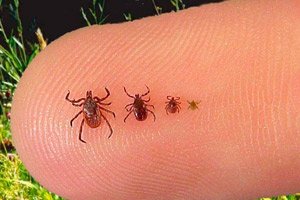
In the summer, there is a high probability of getting a tick bite. This topic must be treated extremely scrupulously. Today, tick bites in people are quite common. This combination of circumstances can lead to serious consequences and even a threat to life. When going on a picnic in the forest, it is necessary to follow certain rules of conduct there. If a tick is found, give it for examination. These and many other issues will be discussed below.
 [ 1 ]
[ 1 ]
The incubation period after a tick bite in humans
Infection occurs directly through the bite of an arthropod. It is the tick that is the carrier of many dangerous diseases for humans. There have been cases where infection occurred through the gastrointestinal tract. No, you do not need to eat the tick for this. But cases of ticks entering the body in this way have been recorded, but only in animals. A person simply needs to drink the milk of an animal that is infected. The incubation period in humans after a tick bite can last up to 30 days. In some cases, it lasts for 2 months.
Most often, the first symptoms begin to manifest themselves 7-24 days after the bite. There were cases when a sharp deterioration in the condition was observed after 2 months. Therefore, it is necessary to monitor the state of health. The incubation period depends entirely on the blood-brain barrier. The weaker it is, the faster the disease will manifest itself, if it exists. You need to pay attention to all strange symptoms, including a common headache. This will allow you to quickly identify the disease and eliminate it.
Symptoms of a tick bite in humans
If the bite was made by an infected tick, then the person is at risk of getting serious diseases. One of them is tick-borne encephalitis. With rapid development, it leads to damage to the nervous system and can lead to inflammation of the brain. Disability and death are not excluded. The main symptoms after a tick bite begin to bother a person after a week.
The symptoms after a bite are very similar to the onset of an acute respiratory disease. A person feels generally unwell, the body temperature rises, and body aches appear. All this may indicate the presence of an infection in the body. Somewhat different symptoms are observed with borreliosis. The whole danger is that there may be no signs for up to six months. Then the bite site begins to turn red and all the above symptoms appear.
Vomiting, migraine, and chills may act as auxiliary symptoms. The person's condition deteriorates sharply. On the fourth day after the onset of the disease, sluggish paralysis may develop. Sometimes it affects the larynx and pharynx, making it difficult for a person to swallow. There have been cases where the reaction was so strong that there were disturbances in the functioning of the respiratory system and heart. Epileptic seizures are possible.
What does a tick bite look like on a human?
Attachment of a tick to a human body occurs through an organ called a hypostome. It is an unpaired outgrowth capable of performing the functions of sensory organs. With its help, the tick attaches itself and sucks blood. Most often, a tick bite in humans is observed in places with delicate skin, and looks like a red spot with a dark dot in the middle. It is necessary to look for it on the stomach, lower back, groin area, armpits, chest and ear area.
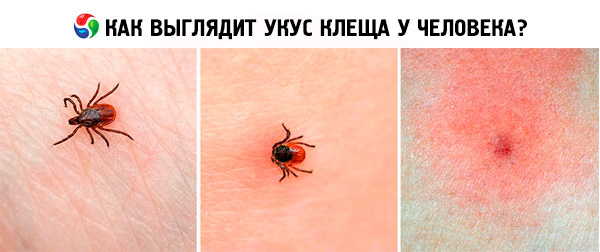
Allergic reactions may occur at the site of the bite. After all, the tick's saliva and microtraumas have a negative effect on human skin. The bite is painless, so the person does not feel it. The bite site is reddened and has a round shape.
A tick bite, a carrier of borreliosis, looks more pronounced. It is characterized by the appearance of a specific spotted erythema. The spot can change size and reach up to 10-20 cm in diameter. In some cases, as much as 60 cm have been recorded. The spot has a round shape, sometimes it takes the form of an irregular oval. Over time, a raised outer border begins to form, it acquires a bright red hue. In the center of the spot, the skin becomes bluish or whitens. The spot somewhat resembles a donut. Gradually, a crust and a scar form. After a couple of weeks, the scar disappears on its own.

Signs of a tick bite in humans
It is important to understand that a small tick bite can lead to serious health problems. Thus, encephalitis can cause paralysis of the limbs and lead to death. There is no need to panic ahead of time. You should be able to distinguish the symptoms and, if they appear, immediately contact a doctor. The likelihood of a favorable outcome is high if a person has signs of an encephalitis tick bite at an early stage.
The first thing that appears is chills. The person thinks that he is starting to get an acute respiratory viral infection or the flu. Therefore, he begins treatment according to his own standard scheme, but it does not help. The chills are accompanied by a rise in temperature, sometimes its indicator is equal to 40 degrees. At the next stage, a headache and nausea appear, sometimes all this is supplemented by vomiting. The person is still sure that it is the flu. Severe headaches are replaced by body aches. Breathing gradually becomes difficult, the person is unable to move normally. His face and skin quickly turn red. This indicates that the virus has begun its harmful activity. After this, irreversible processes begin in the body. Paralysis or death are possible.
Diseases after a tick bite in humans
A tick bite is safe, but only if the tick was not a carrier of any disease. The danger is that most diseases manifest themselves over time. A person forgets about the bites and continues to live as before. Meanwhile, the disease begins to actively progress, all this is accompanied by certain symptoms. Therefore, it is worth noting that after a tick bite, a person can develop the following diseases: tick-borne encephalitis, borreliosis, tick-borne acarodermatitis and dermatobiasis. The first two diseases are especially dangerous.
- Tick-borne encephalitis. Its symptoms are completely consistent with the flu. This is the main danger, people cannot draw a fine line between the two diseases. Distinctive signs appear after the virus has begun its harmful activity in the body. This can be difficulty breathing, paralysis and death. Encephalitis is dangerous because serious symptoms appear quickly and a person simply does not have time to react to it. Meanwhile, serious changes in the central nervous system and brain have already begun.
- Borreliosis or Lyme disease. This disease is not so dangerous, it can be cured with antibiotics. The whole insidiousness of the virus is that it can manifest itself six months after the bite. If you do not submit the tick for examination, there is a risk of the disease becoming chronic. It is complicated by its consequences, including death. A person should be alerted by ring-shaped swellings on the skin, the appearance of fever, cough and nausea. Over time, the picture is supplemented by headache, chills and fever. The development of arthritis, progressive encephalopathy and pericarditis is not excluded.
- Tick-borne acarodermatitis. This is a common allergic reaction to a bite. It manifests itself in the form of severe itching, inflammation and small hemorrhages. It is enough to simply adhere to the rules of hygiene.
- Dermatobiasis. This is a parasitic disease. It can develop if the tick's abdomen contains eggs laid by gadflies. Larvae begin to hatch in the human body. This is very dangerous because they eat the person from the inside. A child's body is not able to withstand such a blow, even with strong treatment.
Ehrlichiosis in humans from a tick bite
This is a dangerous infection that can enter the body after a tick bite. It can be cured with effective treatment. If it is not started, the person will die. Ehrlichiosis is caused by bacteria that are transmitted to the body by a tick bite. The likelihood of getting this disease increases if a person is often in areas where ticks are common. It is worth noting that a tick bite can cause ehrlichiosis in a person. However, not all ticks are carriers of the disease.
Symptoms of the disease may appear 7-14 days after the infection. First, fever and chills appear. Then everything is accompanied by muscle and joint pain. The person thinks that he has caught the flu or a cold and, without going to the hospital, begins his own treatment. Gradually, the symptoms are supplemented by nausea, severe headaches, fatigue. In rare cases, stiffness of the occipital muscles and confusion develop. All this indicates parasitism of the body.
 [ 4 ], [ 5 ], [ 6 ], [ 7 ], [ 8 ], [ 9 ], [ 10 ]
[ 4 ], [ 5 ], [ 6 ], [ 7 ], [ 8 ], [ 9 ], [ 10 ]
Lyme disease in humans from a tick bite
The causative agents of Lyme disease are spirochetes of the genus Borrelia. The phenomenon is widespread on all continents, so it is not so easy to avoid infection. A person who has Lyme disease is not dangerous to others. Bacteria enter the skin of a person with saliva, and after a few days they begin to actively multiply. The danger is that a tick bite can cause a person to develop borreliosis, with further damage to the heart, joints, and brain. Bacteria can live in the human body for years and gradually lead to a chronic form of the disease.
The incubation period is 30 days. On average, symptoms begin to manifest themselves after 2 weeks. In almost 70% of cases, this is reddening of the skin, the so-called erythema. The red spot can change size and shape. Eventually, the bite site becomes covered with a crust, the skin may remain pale or become bluish. A red elevation appears around the affected area, all of this visually resembles a donut. After a couple of weeks, everything disappears. But the danger has not passed, in a month and a half, damage to the nervous system and heart may occur.
Tick-borne encephalitis from a tick bite
Tick-borne encephalitis is a natural focal infection that in most cases affects the human nervous system. This can lead to disability and even death. Infection occurs from a tick bite, which can provoke tick-borne encephalitis. People who like to spend a lot of time outdoors are susceptible to this effect. They need to be especially careful and constantly inspect their body for ticks.
The first signs after a bite can appear after a week. Sometimes it takes a whole month. The first thing that starts is chills, accompanied by an increase in body temperature and a feverish state. The person sweats intensely, is bothered by a severe headache and body aches. If the symptoms do not appear for a long time, even mild muscle weakness can be a reason for panic.
You should seek help if your body temperature rises sharply, you have a severe headache, or you have trouble sleeping. The disease can often cause hallucinations and seizures. All of these symptoms should be a reason to go to the hospital.
Consequences of a tick bite in humans
A tick bite can cause a number of diseases. Naturally, if you do not pay attention to this, serious consequences are possible. Thus, most often, a tick bite can cause irreparable consequences in a person. They arise due to untimely treatment of encephalitis, borreliosis, acarodermatitis and dermatobiasis.
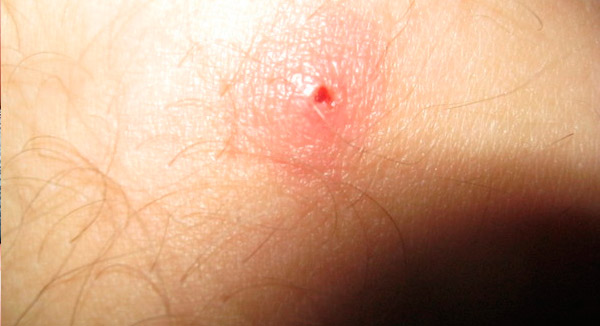
- Encephalitis can lead to serious consequences. It often affects the central nervous system and heart. A person may develop difficulty breathing, and paralysis may develop over time. If treatment is not started in time, the victim may become disabled or die.
- Borreliosis. The danger of infection is that the disease can be "silent" for six months. During this period, irreversible changes can occur in the body. Thus, borreliosis manifests itself as erythema. Redness can appear at the site of the bite, progress over time and eventually disappear. The worst thing begins later, after a month, serious disorders of the central nervous system and heart develop. A fatal outcome is not excluded.
- Acarodermatitis. There are no consequences after such a lesion. A person may be bothered by local allergic reactions, but all this passes with time. The disease does not affect internal organs and systems.
- Dermatobiasis. The disease is especially dangerous for children. If the eggs from the tick's abdomen begin to hatch in the body, a fatal outcome is possible. The child's body is not able to cope with this problem, even with high-quality treatment.
Complications after a tick bite in humans
After a tick bite, various complications may develop. The central nervous system suffers first. Epilepsy, headaches, and paralysis may develop. The cardiovascular system is also particularly affected. Arrhythmia and constant blood pressure surges are possible. The lungs also suffer, pneumonia may develop and, as a consequence, pulmonary hemorrhages. The kidneys and liver are negatively affected. In this case, after a tick bite, a person develops complications in the form of nephritis and digestive disorders.
Encephalitis is especially dangerous. In the best case, it will end in chronic weakness. The body is able to recover on its own after a couple of months. In severe cases, the process can drag on for six months. In the worst case, a person will develop defects that will interfere with his normal life. Persistent changes in the body lead to epilepsy and disability.
Temperature in humans from a tick bite
A sharp increase in body temperature a few hours after the bite indicates that the body responded to such an invasion with an allergic reaction. This occurs due to the saliva of a sterile or infected tick getting under the skin. Therefore, when bitten by a tick, a person's temperature must be constantly recorded, moreover, the victim must be monitored for 10 days. Body temperature must be constantly measured. Fever can manifest itself 2-10 days after the bite. This symptom indicates the onset of infectious pathogenesis.
With tick-borne encephalitis, the temperature may rise 2-4 days after the bite. It lasts for two days and then returns to normal on its own. A second rise is recorded on the 10th day. With borreliosis, body temperature does not change so often. With ehrlichiosis, fever appears on the 14th day. Moreover, it can be elevated for 20 days. Therefore, it is imperative to monitor temperature readings.
Redness after a bite
This symptom is typical of Lyme disease. The site of the tick bite is redder and resembles a ring. This can happen 3-10 days after the bite. In some cases, a skin rash is observed. Over time, the redness after the bite changes size and becomes much larger. Lyme disease is characterized by the appearance of erythema. It is accompanied by high fever, headache, and fatigue. Motor restlessness, muscle and joint pain are possible. Swelling of the tonsils is often observed.
Over the next 3-4 weeks, the rash begins to gradually fade and the spot may disappear completely. A person, as a rule, does not pay attention to all this. The danger still remains. Thus, after a month and a half, serious complications from the central nervous system may appear. Therefore, it is imperative to monitor redness and tick bites in general!
Lump at the site of a tick bite
Often, the human body reacts negatively to the introduction of a tick into it. Thus, the bite site begins to turn red, in some cases a lump appears. Why does all this happen and is there any danger in it? It should be understood that a lump at the site of a tick bite can be caused by an ordinary allergic reaction. It occurs due to the piercing of the skin by the proboscis and the ingress of saliva into it. Moreover, it is not necessary for the saliva to be infected, even in a sterile form it can provoke an allergic reaction. Itching, redness and slight compaction are normal reactions of the body. But, you should not relax.
If the tick was submitted for examination, and it confirmed the absence of dangerous bacteria in it, there is no reason to worry. When the lump appears after some time, and the tick was not checked, there is a reason to worry. It is necessary to go to the hospital immediately. This may indicate infection. Diseases caused by ticks were described above.
A lump may appear due to improper removal of the tick. In some cases, the tick's body is successfully removed, but its proboscis remains in the skin. Therefore, the removal process must be monitored more carefully. If a lump appears and additional symptoms such as fever and headache, you must immediately go to the hospital.
Diarrhea after a tick bite
Intestinal upset is not observed so often, but it can be one of the signs of a serious infection of the body. Each person is individual and even a bite of an uninfected tick can lead to a number of negative reactions. The affected area can turn red, over time itching and rash appear. The intestines can also react negatively after a tick bite, causing diarrhea.
These symptoms are twofold. In one case, they may indicate weakness of the body, in another – indicate infection. Therefore, if negative symptoms appear, including intestinal upset, you need to go to the hospital. Even if the person feels better after a while. Many diseases transmitted by ticks begin to manifest themselves 2 weeks after the bite. During this period, the infection can develop in the body and lead to irreversible processes.
Lump after bite
A lump after a bite may indicate that an infection has entered the body. If this symptom appears along with redness, itching, and a rash, you should immediately consult a doctor. This could be either an incorrect removal of the tick or the development of a serious disease. Often, a lump forms after a bite, its development is provoked by an allergic reaction. Perhaps this is the most harmless thing that can happen.
By piercing the skin with its proboscis, the tick begins to suck. This process can cause itching, redness and even rawness. Often, after removal, a lump appears. However, this symptom is not so harmless. It is quite possible that an infection has begun to develop in the human body. This could be encephalitis or borreliosis. You should immediately seek help at the hospital.
Often people remove the tick itself incorrectly. This leads to its proboscis remaining in the skin. This causes an inflammatory process, severe irritation and compaction. Doctors will help to cope with this problem.
Who to contact?
Treatment after a tick bite in humans
The first step is to remove the tick. You can do this either yourself or by going to the hospital. It is imperative to save the live tick and take it for examination. If it was killed during removal, it is worth putting it in a container with ice. In any case, the tick must be submitted for examination! After all, bites can cause a number of dangerous diseases. It is important that after a tick bite, a person is correctly diagnosed with the disease and prescribed effective treatment.
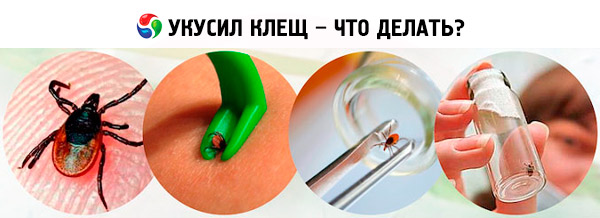
Treatment of the bite is carried out with antibiotics. However, they are not always used to eliminate the infectious agent. Antibiotics are not used to eliminate encephalitis.
- Tick-borne encephalitis. First of all, a person needs to be put on bed rest. It is desirable that it be at least a week. In the first three days, the victim should take human immunoglobulin. It is recommended to resort to the help of such means as: Prednisolone, Ribonuclease. Blood substitutes are also suitable, these are Rheopolyglucin, Polyglucin and Hemodez. If meningitis is observed, an increased dose of vitamins B and ascorbic acid is recommended. In case of respiratory failure, intensive ventilation of the lungs is used.
- The treatment regimen for borreliosis is somewhat different. The first step is to hospitalize the patient. At the stage of erythema, he should take Tetracycline. Bacteriostatics play a special role in the treatment. These can be Lincomycin and Levomycetin. If a neurological syndrome is observed, it is stopped by intravenous injections of bactericidal antibiotics. These can be Azlocillin and Piperacillin. Water balance is restored by means of blood substitutes, such as Rheopolyglucin and Polyglucin.
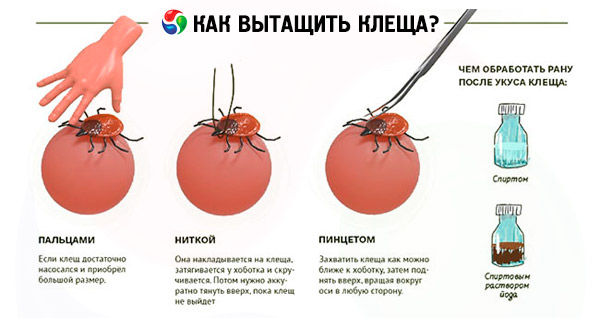
Where to go if a person has symptoms of a tick bite?
If you are bitten by a tick, you need to follow a special algorithm. First, you need to remove the tick. Then you take it to a special accredited laboratory. This will help identify the presence of pathogens. The study is carried out using the PCR method, directly in the tick's body. A person needs to donate blood to detect antibodies. After all, bites can cause serious consequences. The victim is recommended to undergo a course of treatment based on the results of laboratory tests. If symptoms of a tick bite appear in a person, you need to know where to go.
Where can you hand in a tick and how can you test it? You need to find a hospital that does such testing. You can find the address of the laboratories and phone numbers on the Internet. Just visit the website of the Ukrainian Consumer Rights Protection and Human Wellbeing Service. In fact, ticks should be accepted in every hospital that has a laboratory. Most importantly, the test is completely free! It is recommended to clarify this information. The results are provided on the day of tick testing or the next day.
How to treat a tick bite on a person?
If a tick is found on the body, it must be removed immediately. An experienced specialist can help with this. In the hospital, the tick is immediately submitted for examination, because a tick bite in a person can provoke the development of serious diseases, so it is necessary to know how to treat the affected area. In outpatient treatment, a person is recommended to take immunoglobulins. Most often, the drug Rimantadin is prescribed. It is taken for 3 days, one tablet in the morning and evening.
At home, the tick is removed using oil. It is necessary to drip a lot of it on the head of the tick. Alcohol is also used for this purpose. After 15 minutes, you can begin removing it. In most cases, the tick comes out on its own. It is much easier to remove it this way, just use tweezers and pull the tick out with circular movements. It is recommended to treat the bite site with hydrogen peroxide. Further recommendations can be obtained at the hospital. Usually, the affected area is not treated with anything else.
Tablets for tick bites in humans
If there is a risk of developing encephalitis in a person or the diagnosis has been confirmed, they begin to take human immunoglobulin. This can be Prednisolone and Ribonuclease. Blood substitutes such as Rheopolyglucin, Polyglucin are actively used. All these tablets from a tick bite do not allow the infection to spread throughout the human body and lead to serious damage to the body.
- Prednisolone. The dosage regimen is individual. Usually the drug is used once a day. It is actively used to eliminate the consequences of tick bites. It is not recommended to take the drug in the presence of fungal infections and intolerance. Hypokalemia, flatulence, sleep disorders and negative nitrogen balance may develop.
- Ribonuclease. For the treatment of tick-borne encephalitis, the drug is administered intramuscularly 6 times a day. The dose can be adjusted. The drug should not be used in case of respiratory failure, bleeding and tuberculosis. Allergic reactions may develop.
- Rheopolyglucin and Polyglucin. The drugs are administered intravenously at a rate of 60 drops per minute. The maximum amount is 2.5 liters. They cannot be used in case of head injuries and diabetes. They can lead to the development of allergic reactions. Very rarely causes arterial hypotension.
- In case of borreliosis, slightly different drugs are used. Rheopolyglucin and Polyglucin are also used as hematopoiesis drugs. At the initial stages of erythema, Tetracycline is used, as well as bacteriostatics: Levomycetin and Lincomycin. Azlocillin and Piperacillin are used as bactericidal antibiotics.
- Tetracycline. The drug can be used both in the form of tablets and ointment. The ointment is applied to the affected area every 6 hours. As for tablets, 250-500 mg are used with the same frequency. The drug cannot be used by children under eight years of age, as well as pregnant women. The development of diarrhea, constipation, allergic reactions is possible.
- Levomycetin and Lincomycin. When taken orally, the dose is up to 500 mg. In this amount, the drugs are used up to 4 times a day. The duration of treatment is usually 10 days. The drugs cannot be used in case of liver and kidney dysfunction. A similar requirement is put forward for children and pregnant women. Possible development: leukopenia, depression and skin rash.
- Azlocillin. The drug is administered intravenously. The maximum dosage is 8 grams. That is, 2 grams 4 times a day. People with allergic reactions should not take it. It can cause nausea, vomiting, anaphylactic shock.
- Piperacillin. The drug is administered intravenously over 30 minutes. The daily dose is 100-200 mg. The medication is administered up to 4 times a day. It should not be taken in case of hypersensitivity, pregnancy and lactation. It can lead to headaches, skin hyperemia and dysbacteriosis.
Prevention of tick bites in humans
Prevention is entirely based on several basic rules. First of all, vaccination is necessary. This will help avoid serious consequences in the future. If a person is already infected, it is inappropriate to carry it out. The second criterion for prevention is specific immunotherapy. It is a therapeutic measure in which immunoglobulin is introduced into the human body. Prevention of tick bites should be carried out more carefully in people whose activities are directly related to working in nature.
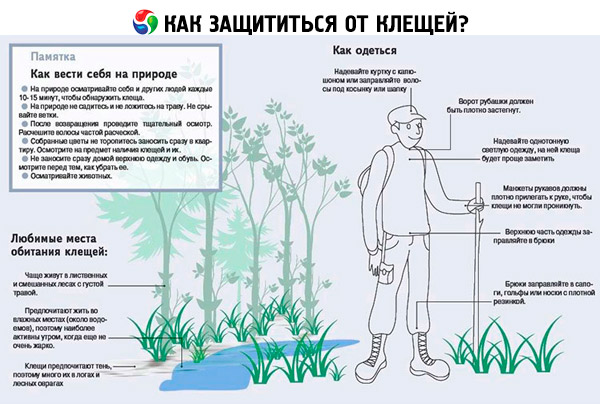
It is important to dress properly when going to the forest or outdoors. Special clothing will prevent ticks from getting under it. You can use special repellents. These can be sprays or creams that are applied to the skin. All this will help avoid bites and further infection. Following simple rules and checking the body after returning from nature will protect a person and prevent possible serious consequences.
Forecast
The further course depends on how quickly the person reacted to the lesion. If he ignored the symptoms and did not consult a doctor, the prognosis is extremely unfavorable. The fact is that tick bites can manifest themselves only after some time. This is the main danger. The first symptoms can appear within a week and subside after a few days. Then they flare up with renewed vigor, but entail serious damage to the central nervous system and brain. This can lead to the development of epilepsy, paralysis, disability and even death. Naturally, the prognosis in this case is unfavorable.
If a person notices a tick on themselves in time, removes it and submits it for examination, the probability of a good outcome is high. After all, even if the tick is infected, based on the results of the examination, the person will be prescribed high-quality treatment. This will prevent all serious consequences. The favorable prognosis depends entirely on the person.
Death from a tick bite in humans Death after a bite can occur for a number of reasons. In most cases, this is due to infection with serious diseases such as encephalitis and borreliosis. Many people ignore the symptoms and are in no hurry to see a doctor. Meanwhile, the disease begins to actively progress. Encephalitis is especially dangerous; such a tick bite can cause death in humans.
The disease can manifest itself at the initial stage and then fade away. After which it returns with renewed vigor and leads to serious damage to the central nervous system and brain. Often this causes a fatal outcome. Lyme disease is also dangerous. It can manifest itself six months after infection. And everything happens instantly. Animals can die instantly. Finally, dermatobiasis. This disease causes a fatal outcome in children. The body of adults is more adapted to this infection.
It is necessary to constantly monitor children, check their skin and your own body. If anything happens, immediately contact a doctor and eliminate the disease. This is the only way to avoid adverse consequences, including mortality.

